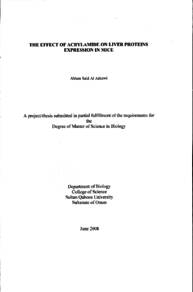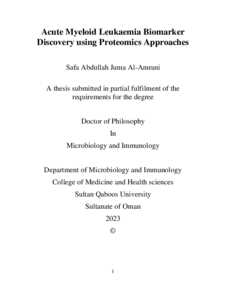Document
The effect of acrylamide on liver proteins expression in mice
Publisher
Sultan Qaboos University
Gregorian
2008
Language
English
Subject
English abstract
Acrylamide in drinking water was administrated to the C57BL/6 male mice at different concentrations during a nine week experimental period. The main objective was to utilize the proteomics tools like the SDS-polyacrylamide gel electrophoresis (SDS-PAGE) and two-dimensional gel electrophoresis (2DE) to study the proteomics of liver upon acrylamide intoxication been liver the major site of acrylamide metabolism and detoxification. However, the mice general health including blood parameters, weight changes and liver gross appearance were also investigated. The data were analysed and correlated with different acrylamide concentrations throughout the experimental period. The results from both control and the experimental mice were compared to analyse the effect of acrylamide on the experimental mice. Overall the acrylamide at different concentrations used in this study (0, 0.5, 5, 50, and 500 ug acrylamide/kg,) did not have a significant effect on the general health of the mice and both the controls and the experimental had little effect on general physiological conditions. It appeared that the experimental mice tolerated the specific concentrations used in this study and perhaps the acrylamide was not enough to cause any major side effect. However, the proteomic studies of the liver have clearly shown that the protein expression is effected by ingestion of acrylamide in drinking water. While the SDS-PAGE pattern of liver proteins showed minimal variations, analysis of the 2-D gel maps of the controls and lowest acrylamide treatment group using the Image Master software has reported at least 10 proteins which founded to be significantly affected (T > 2) by the acrylamide treatment. Five proteins were possibly identified using the ExPASy server of the SWISS-2DPAGE database. The affected proteins were up-regulated or down-regulated depending on their physiological function whether involved in the metabolism and detoxification of acrylamide or play a role in protecting the cells from a probable damage. The results of this study, although preliminary, show that proteomics is a valuable tool for toxicity studies, since it allows the analysis of proteins of treated animals in comparison to the control map to establish treatment-related differences.
Member of
Resource URL
Arabic abstract
في هذه الدراسة أعطيت مادة الأكريلماید Acrylamide) السامة بتراكيز مختلفة مضافة إلى ماء الشرب إلى ذكور فئران من فصيلة 6/C57BL لفترة إختبار إمتدت الى 9 أسابيع. وبما أن الكبد يعتبر العضو الرئيس في عملية إزالة السموم و أيض الأكريلمايد فإن الهدف الرئيس من هذه الدراسة كانت تحليل مدى تأثير هذه المادة على التغيرات البروتينية في الكبد مستفيدين من الطرق المطروحة في علم البروتينات (The Proteomics) كإستخدام سلفات دوديسيل الصوديوم في عملية الهجرة الكهربائية للدقائق المعلقة في جل البوليأكريلماید SDS) (PAGE وعملية الهجرة الكهربائية ذات البعدين (2-DE). وبجانب دراسة البروتينات في الكبد فإن البحث اشتمل معاينة تأثير هذه المادة على الوضع الصحي العام للفئران كتحليلات الدم والوزن ودراسة المظهر الخارجي العام للكبد (Gross morphology). تم تحليل النتائج وربطها بالتراكيز المختلفة المستخدمة من هذه المادة طوال فترة البحث وبعدها تم مقارنة نتائج الفئران المسمومة والفئران المستخدمة كمقياس ( Control) لمعرفة مدى تأثير هذه المادة. وبشكل عام فإن التراكيز المستخدمة من هذه المادة في هذه الدراسة ( 0. 5 و 5 و 50 و 500 غرام / كيلوغرام من وزن الجسم) لم تؤثر فعليا على الحالة الصحية العامة والفسيولوجية وظهر لنا أن الفئران قد تحملت التراكيز المستخدمة وربما أن هذه الكميات لم تكن كافية لإظهار أعراض جانبية. ولكن تحليلات الكبد وهي الأهم أظهرت أن هذه المادة قد أحدثت تأثيرات على مستوى البروتينات في الكبد. ورغم أن نتائج التحليل بواسطة SDS - PAGE أظهرت تأثيرات بسيطة الا أن عملية DE-2 وباستخدام برنامج ال Image Mater لمقارنة نتائج الفئران (Control) والمسمومة بأقل التراكيز قد أظهرت أن ما لا يقل عن 10 بروتينات في الكبد قد تأثرت تأثيرا ذو دلالة من فعل هذه المادة. وباستخدام برنامج SWISS -2DPAGE database عن طريق شبكة ال ExPASy تم بشكل تقريبي التعرف على 5 من هذه البروتينات المتأثرة التي تلخص تأثيرها في ارتفاع نسبة بعضها في الكبد وهبوط إنتاج الأخريات كلا على حسب الوظيفة الفسيولوجية التي تقوم بها سواء كانت في عمليات أيض الأكريلمايد أو حماية الخلايا الكبدية من أي أضرار محتسبة. هذه الدراسة وإن كانت نتائجها أولية إلا أنها أظهرت أن علم البروتينات (The Proteomics) هو علم فعال في دراسة تأثير السموم حيث أنها تمكن من دراسة البروتينات في الحيوانات المسمومة ومقارنتها بتلك غير المسمومة للتمكن من دراسة الإختلافات الناتجة عن السموم.
Category
Theses and Dissertations


